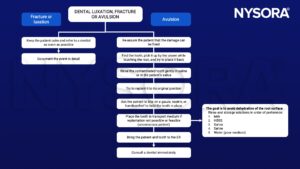Learning objectives
- Management of dental emergencies resulting from airway management to maximize the chances of saving the tooth
Definition & mechanisms
- Tooth luxation occurs when trauma disrupts the tissues, ligaments, and bone that hold the tooth in place
- Can also affect the tooth’s nerves and blood supply
- Tooth avulsion occurs when the tooth is completely dislodged from its socket
- Avulsed teeth are dental emergencies and require immediate treatment
Signs and symptoms
- Teeth that are mobile or completely dislodged from the jaw due to airway management
Risk factors
- Bad dental hygiëne
- Difficult intubation
- Laryngoscopy by an inexperienced operator
Management

Suggested reading
- Bourguignon C, Cohenca N, Lauridsen E, et al. International Association of Dental Traumatology guidelines for the management of traumatic dental injuries: 1. Fractures and luxations. Dent Traumatol. 2020;36(4):314-330.
- Fouad AF, Abbott PV, Tsilingaridis G, Cohenca N, Lauridsen E, Bourguignon C, et al. International Association of Dental Traumatology guidelines for the management of traumatic dental injuries: 2. Avulsion of permanent teeth. Dent Traumatol. 2020;36(4):331-42.
We would love to hear from you. If you should detect any errors, email us [email protected]







